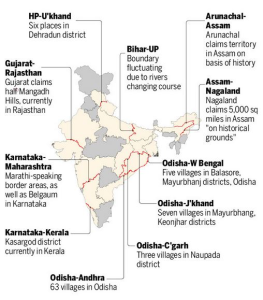Approach:
- Introduction.
- Pointwise mention the key aspects of some of the major disputes.
- Conclusion.
Frequent inter-state border disputes put into peril India’s cooperative federalism. The Union Home Ministry had recently informed the Lok Sabha that 11 States and one Union Territory have boundary disputes between them and “occasional protests and incidents of violence are reported from some of the disputed border areas”.

- There are boundary disputes arising out of demarcation of boundaries and claims over territories between Andhra Pradesh-Odisha, Haryana-Himachal Pradesh, UT of Ladakh-Himachal Pradesh, Maharashtra-Karnataka, Assam-Arunachal Pradesh, Assam-Nagaland, Assam-Meghalaya, Assam-Mizoram.
- Some matters related to division of assets are pending between Andhra Pradesh-Telangana and Bihar-Jharkhand.
- Karnataka – Maharashtra: The Belgaum district is the source of border dispute since it hosts a large Marathi & Kannada-speaking Upon state reorganization, this area came under Karnataka in 1956 (previously part of Bombay Presidency).
- Assam-Mizoram: This dispute is the legacy of 1875 & 1933 British notifications. Previously Mizoram, called Lushai Hills was differentiated from the Cachar plains & the other demarcated boundary between Lushai hills & Manipur. While Mizoram became a state in 1987, it still insists on the 1875 boundary. Assam wants the boundary demarcated in 1986. Mizoram says the 1986 agreement is not acceptable as the Mizo civil society had not been consulted.
- Meghalaya – Assam: Dispute started when Meghalaya challenged the Assam Reorganisation Act 1971, which gave Blocks I & II of Mikir Hills (Karbi-Anglong) to Assam. Meghalaya contends that both these blocks were part of erstwhile United Khasi & Jaintia Hills district. Presently, 12 dispute points cohabit the 733 km long border. While Assam goes by the Churachand Committee recommendations, Meghalaya rejects it.
- Assam – Nagaland: Longest running border dispute, soon began after Nagaland’s statehood in 1963.The Nagaland States Act 1962 had defined the state’s borders according to a 1925 notification when Naga Hills & Tuensang Area were incorporated into Assam. Nagaland rejects the delineation, demanding inclusion of all Naga-dominated areas in North Cachar & Nagaon districts. They both claim Merapani, a small village next to Assam Plain’s Golaghat district.
- Arunachal Pradesh – Assam: Arunachal grieves that reorganisation has unilaterally transferred several forested tracts traditionally belonging to hill tribes to Assam. After Arunachal’s statehood in 1987, a tripartite committee recommended transfer of some territories from Assam to Arunachal, which stands still contested.
- Himachal Pradesh – Ladakh: They lay claim to Sarchu, an area on the route between Leh & Manali.
- Haryana – Himachal Pradesh: They dispute over the Parwanoo region, next to the Panchkula district in Haryana. Haryana claims a large part of this area, alleging encroachment by Himachal.
- Odisha vs four states:
- Odisha continues to have unresolved border disputes with four neighbouring States (Andhra Pradesh, West Bengal, Chhattisgarh, Jharkhand) in its eight out of 30 districts even decades after Independence.
- Odisha has a long history of disputes with Andhra Pradesh which shares border with the State in five districts — Koraput, Malkangiri, Rayagada, Gajapati and Ganjam.
- Phattuseneri is one of 21 villages in Kotia gram panchayat that lie at the centre of a longstanding border conflict between Odisha and Andhra Pradesh.
- Odisha is trying to settle border disputes with West Bengal on the basis of revenue maps drawn by then Balasore District Collector in 1938.
- The border dispute between Odisha and Jharkhand arises due to change in course of river Baitarani.
The Union Home Minister had urged all the north-eastern States to resolve their boundary disputes by August 15, 2022, when the country celebrates 75 years of Independence. However, to strengthen this unity furthermore, both the Centre and state governments need to imbibe the ethos of cooperative federalism.
